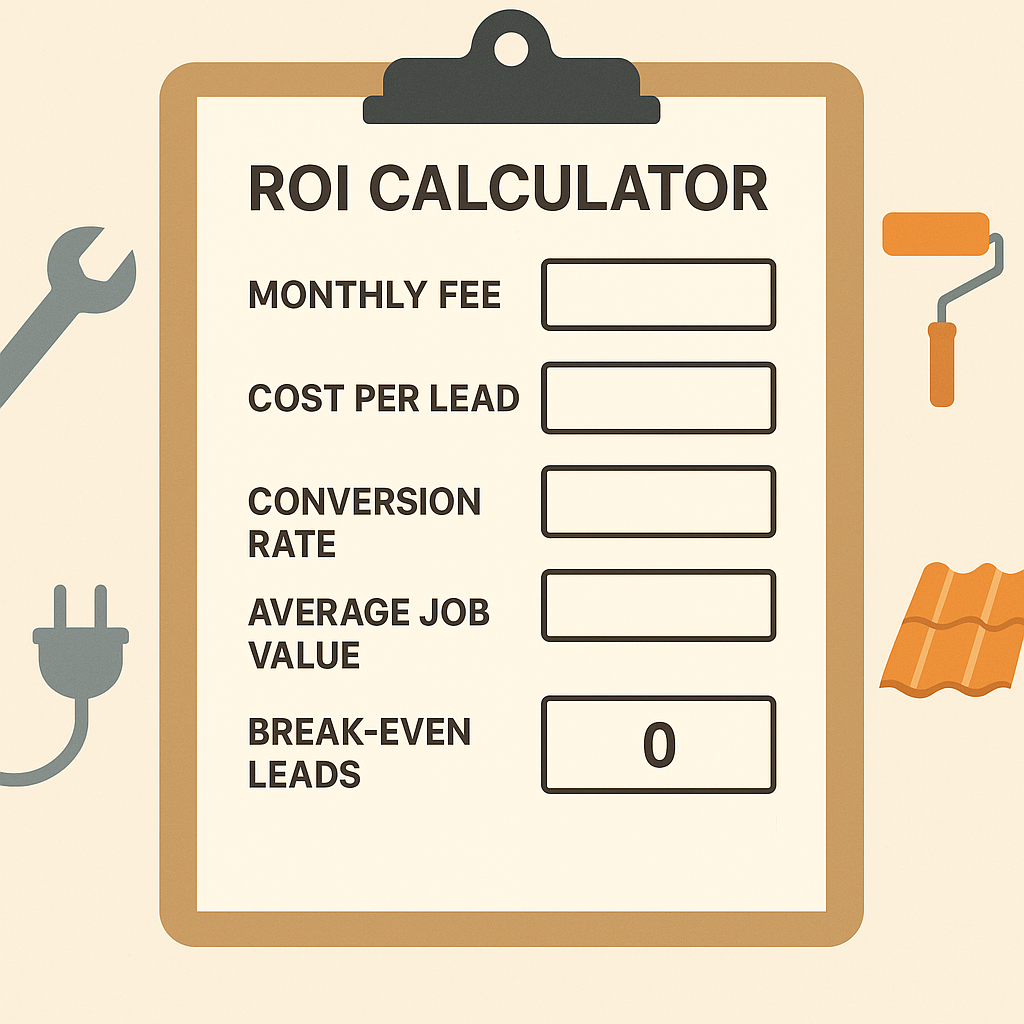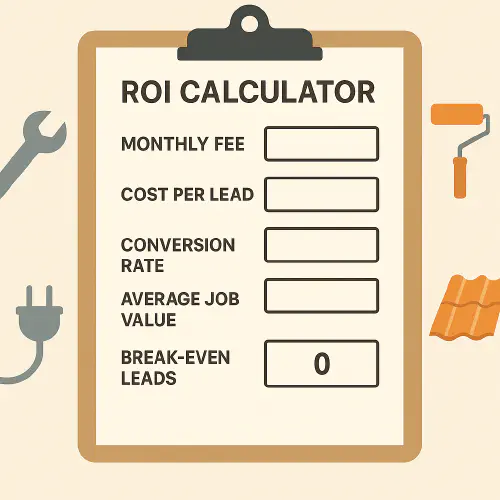
Is Checkatrade worth it? Simple ROI calculator and a lead‑mix plan that actually works
Is Checkatrade worth it? Simple ROI calculator and a lead‑mix plan that actually works
Category: Marketing & Sales • Niche: Lead generation, directories, ROI
Contents
- Quick answer
- What you really pay for
- Build your break-even ROI in 5 minutes
- Benchmarks by trade
- Lead‑mix plan that reduces risk
- Qualify paid leads fast
- Trials, discounts and refunds
- What are people saying on Reddit?
- FAQ

Clipboard-style ROI calculator for Checkatrade style directories, with UK trade icons
Quick answer
- Checkatrade and similar directories can work if your paid-lead maths adds up. That means your average profit per job comfortably covers: membership, extra time spent chasing, and the duds.
- Use the simple calculator below to get a yes or no in minutes. If the numbers are tight, reduce risk with a balanced lead‑mix (directories + referrals + inbound) before committing long‑term.
Useful context:
- Checkatrade posts its own stance on membership ROI here: Is Checkatrade Membership Worth It?
- Independent comparisons of platforms: Tradesman Saver roundup and Trade Skills 4U guide
What you really pay for
You’re buying:
- Visibility and trust badge. Lots of homeowners start on directories.
- A stream of non‑exclusive leads. You must respond fast and qualify hard.
- Reviews hosting. Helpful, but you don’t own them if you leave.
You’re not guaranteed:
- Exclusivity. Several trades may receive the same enquiry.
- Job size fit. Many small jobs or tyre‑kickers if you don’t screen.
- Profit. You still need tight pricing, deposits and a process.
Build your break-even ROI in 5 minutes
Copy this framework into a notes app or spreadsheet and plug your numbers.
Inputs:
- Monthly fee: £
- Average cost per lead: £ (if applicable)
- Lead to quote rate: %
- Quote to win rate: %
- Average job value: £
- Gross margin on job: %
Formulas:
- Leads to a job = 1 / (lead to quote × quote to win)
- Gross profit per job = job value × gross margin
- Cost per job from platform = monthly fee + (leads × cost per lead) divided by jobs won
- Break‑even leads per month = monthly fee ÷ (gross profit per job × win rate × quote rate)
Worked example (plumber, small jobs):
- Monthly fee £180, pay‑per‑lead £0
- Lead to quote 60%, quote to win 35%, average job value £240, margin 50%
- Leads to a job ≈ 1 / (0.6 × 0.35) = 4.76
- Gross profit per job = £240 × 0.5 = £120
- Break‑even leads per month = £180 ÷ (120 × 0.35 × 0.6) ≈ 7 leads
- If you expect fewer than 7 good leads a month, don’t lock into a long term deal yet.
Tip: track this weekly for 8 weeks before deciding to scale up or cancel.
Benchmarks by trade
These are directional only. Your area and response speed matter.
- Plumbing and heating: 4 to 7 leads per won job. Avg job value often £150 to £400 for call‑outs. Response within 5 minutes changes everything.
- Electrical: 5 to 8 leads per won job for small works. Larger rewire/EV jobs skew the average.
- Roofing: Wider spread. 6 to 12 leads per won job. Ticket sizes vary massively; qualify photos up‑front.
- Decorating and joinery: 5 to 9 leads per won job. Mid‑size tickets, quality photos and references help.
Cross‑check market chatter: MoneySavingExpert forums and Reddit threads often highlight competition and response-time issues. See examples in the Reddit section below.
Lead‑mix plan that reduces risk
Aim for balance so you’re not reliant on one platform.
Baseline mix for a 3‑person firm:
- Directories 30 to 40 percent of new leads in months 1 to 3 while you test.
- Referrals and repeat 30 to 40 percent. Ask on every invoice and use a simple incentive.
- Inbound 20 to 30 percent. Google Business Profile, local partnerships, and a basic website with photos and testimonials.
Adjust the dials monthly:
- If directory ROI is under target, shift budget to partnerships and inbound.
- If inbound is slow, keep a small directory spend but tighten qualification.
Fast local partnerships that work:
- Estate agents and landlords for responsive trades.
- Bathroom/kitchen showrooms for plumbers, tilers, sparkies, joiners.
- Roofing merchants and scaffolding partners for roofers.
Qualify paid leads fast
Use this 3‑minute screen on first contact:
- Ask for postcode, photos/video, preferred time, and budget range.
- State a ballpark from‑price and minimum call‑out to filter tyre‑kickers.
- Offer two next steps: video quote slot or site visit with refundable deposit.
Red flags:
- No address, “need it tomorrow,” or “just after a ballpark” and won’t share photos.
- Long travel for a tiny job. Decline politely and recommend someone closer.
Trials, discounts and refunds
Before you commit:
- Ask for a short trial, price cap, or flexible area boundaries.
- Clarify refund policy on dead leads and how to report them.
- Test one trade category and one postcode cluster first. Log every lead outcome.
Useful external reading:
What are people saying on Reddit?
- r/DIYUK discussions regularly note that good response time and clear quotes win on directories, but some trades complain about competition and low-intent leads. Example threads:
- r/ukelectricians: pricing changes and lead caps are hot topics:
FAQ
How do I know if my numbers are good enough to stay subscribed?
Track 4 numbers weekly: leads received, quotes sent, wins, average profit per job. If your break‑even leads per month are higher than what you’re getting for two straight months, pause or renegotiate.
Can I get exclusive leads?
Most directories are non‑exclusive. Some have premium options in certain areas but expect higher costs. If exclusivity is crucial, focus on partnerships and inbound.
What’s the best alternative to directories?
There’s no single best. A mix of Google Business Profile, local partnerships and a simple referral scheme is reliable and usually cheaper per job over a quarter.
How fast should I reply to leads?
Within 5 to 10 minutes if you can. Use quick‑reply templates and a rota so someone always answers.
Any good video that covers the decision?
This explainer summarises the decision process neatly: https://www.youtube.com/watch?v=XavMSaDekmw
Want to slash training times and increase revenue per Engineer? Join our Waitlist: https://trainar.ai/waitlist